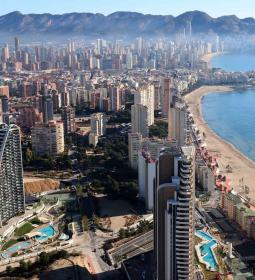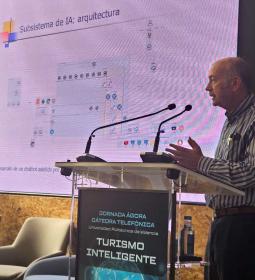This first phase of the project covers more than 1.5 kilometers of Poniente and will be extended to all the beaches in a second
Benidorm implements a monitoring system to measure the influx of people to its beaches

-
In August, nearly 600,000 entries were registered to this stretch of Poniente beach, with an average of almost 20,000 daily.
The analysis of the data will allow a more adjusted management of the services and have a new indicator for calculating the floating population.
Benidorm City Council has implemented a monitoring system through cameras to measure the influx of people to its beaches, thus knowing the degree of occupation of the beaches every day of the year. The project, which is in the first phase of implementation, has already operated during July and August in a stretch of just over 1.5 kilometers from Poniente beach, as explained this morning by the mayor, Toni Pérez, during the presentation of the project and its first results. A presentation that has been made in the Smart Office of the Town Hall in which the Councillors for Beaches and Innovation, Mónica Gómez and Aida García Mayor, participated as well as the chief engineer Vicente Mayor; and Mª Carmen Azorín, municipal innovation agent.
The mayor explained that this first phase of the project 'Image and data analysis system in areas of great tourist influx' is included in the 'Benidorm DTI + Seguro' Tourism Sustainability Plan, and has involved an investment of 150,000 euros and places the city at “the vanguard of innovation”.
The measurement of flows of people on the beaches, has exposed Toni Pérez, "is one of the actions and options that is discussed in many congresses" but that in Benidorm "materializes as a case of use", delving into "the path is undertaken with our conversion into the first certified Smart Tourism Destination in the world”.
The project consisted of "the installation of 20 capacity control cameras in the section of Poniente beach that goes from Paseo de Colón to Vela Blanca ravine, at the junction of Armada Española and Vicente Llorca Alós avenues".
As detailed by the technicians, the cameras have built-in object counting and control software, which, from anonymity, detects people in motion until they leave the camera's viewing range. The cameras register information and display it in real-time on a 'dashboard' in which the number of people entering or leaving the beach is registered.
This makes it possible to have a complete x-ray of the influx of people to the beaches, and therefore of their occupation, "24 hours a day, 365 days a year", as the mayor highlighted. At the moment, the data for July and August are already available, which have resulted in 332,068 and 599,179 visits to the beach in the monitored section, respectively. The summary establishes that the average number of entries in July was around 11,000 people per day, and more than 19,300 in August, with Elche Park being the busiest point, with 110,200 entries in July and more than 150,000 in August.
These “totally anonymous” data are collected daily and are already being reflected in a monthly summary. From "this knowledge of the data" offered by "innovation, technology, and governance" it will be possible to "make accurate decisions". Thus, for example, it will be possible to order and adjust beach services more precisely, react to possible emergencies, or have "a new indicator for calculating the floating population, especially people who spend the day in Benidorm but "don't spend the night in the city."

Second phase of the project
The mayor has indicated that in addition to the already monitored section of the Poniente beach, "this first phase of the project also includes taking this technology to the Mal Pas beach, an action that we have postponed until after these moments of high season since it requires a small “technological operation” on Paseo de Colón.
Once this first phase is completed, the forecast is “in a second, to reach the entire coastal front with this technology,” including the pending Poniente stretch and the entire Levante beach.
This second phase will be part of the actions of the Red.es project and has “a greater complexity of implementation”, basically due to how the accesses to Levante and the Poniente section that goes from the end of the promenade to Tamarindos are structured. While access to the already monitored section is carried out practically exclusively through ramps and stairs, in the rest of Poniente Beach and Levante Beach the entrance and exit can be done from any point on the sidewalk. Hence, the configuration and installation of the camera system must be adapted to this peculiarity.












